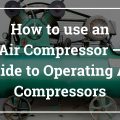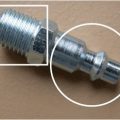Hey! This site is reader-supported and we earn commissions if you purchase products from retailers after clicking on a link from our site.
Water build up in an air compressor can cause significant damage to the compressed air system and its connected air tools if not removed. There are numerous approaches to removing the water condensate from compressed air lines, including water traps and various types of air compressor dryers.
You may wish to make your own homemade air compressor dryer to tackle the water in your air stream. This article will provide you with useful demonstrations on how to DIY and review each method presented.
Table of Contents
- How to Build a Homemade Compressor Dryer Tips
- How to Build a Homemade Compressor Dryer YouTube Demonstrations
- FAQs (Frequently Asked Questions)
How to Build a Homemade Compressor Dryer Tips
A few things I will say before providing you with some demonstrations are that you should but great thought and planning into any idea you have on building your own DIY air compressor dryer, before executing the idea!
As you will know, compressed air can be dangerous so please don’t cut any corners in the process, take your time and ensure you create a system well up to standard! If you’re working with copper and need to practice soldering beforehand, then do so. The same applies to anything!
Upon completing your homemade air dryer, remember to account for the pressure loss across the compressed air system so that your air tools and devices at the end of the line receive sufficient air to operate effectively.
How to Build a Homemade Compressor Dryer YouTube Demonstrations
Building a homemade air dryer can be an intense job and take some amount of time to complete
I have picked out multiple useful YouTube demonstrations on how to build a homemade air compressor dryer that may suit your requirements. Some are harder than others, so I will provide you with tips as to whether this is suited to your skill level.
Method 1: DIY Compressed Air Dryer
The first one I’ve picked out is this video tutorial to help you build an air dryer to eliminate the water from your airline. This build is relatively easy and suited to beginners and will provide you with an efficient air dryer.
You will be using copper rubbing in this method. Copper pipe is the material choice as it’s very durable and allows you not to worry about the loss of air or moist air.
Upon getting your measurements you should connect all the pipe pieces with the pipe fittings together to build your air dryer. The creator of this YouTube demonstration treated the copper pipe and then filled all the holes.
Difficulty: Moderate
Score: 4/5
Method 2: Homemade Compressed Air Dryer
This next one is made from a 1991 Ford A/c condenser with high pressure and high temperature hoses, copper lines, compression fittings and an air moisture filter.
The moisture filter is placed before the air goes back into the tank so that there is less moisture going into the main tank. With the build lowering the temperature of the air in the tank by over 200 degrees.
This creator also had a fan and connected it to the A/c condenser that he pulled from the Ford car. You should be able to acquire most of these essential materials from cars in a local junkyard, or if you have a junk car that has an A/c condenser.
Difficulty: Challenging
Score: 5/5
Method 3: Air Compressor Air Dryer
This demonstration will teach you how to build a simple air dryer system using copper pipes and a dual Burisch BT390T air compressor setup. If you wish to follow a similar approach to this method, the first thing you should do is sketch/make a plan of the air dryer system on paper.
This guide is effortlessly done by the creator and so you should have no issues. One thing I will say, I think they use way too much PTFE tape than is required. You should only need to apply 2 to 3 wraps of the tape on the threads (or 4 to 5 if the threads are deep).
Difficulty: Moderate
Score: 3/5
Method 4: DIY Air Compressor Air Dryer
This creator provides a very good explanation of his DIY compressed air dryer. It’s a well put together structure that allows the tubing and other devices to hang on the wall with the aid of wood.
The creator makes this relatively challenging build easy with his in depth information so you should be able to recreate this in your home or shop!
Difficulty: Moderate
Score: 5/5
Method 5: Homemade Air Compressor Moisture Trap
This demonstration is cheap and easy to build. The creator lists the parts at the end of the video and provides Amazon links in the description.
This creator started with a 60-gallon air compressor that feeds into a regulator, moisture trap and then to the air supply.
Difficulty: Easy
Score 4/5
Method 6: Copper Serpentine DIY Moisture Trap for Compressed Air
This “ultimate” DIY compressed air dryer setup is quite advanced so if you’re a beginner I’d look at one of the other demonstrations reviewed in this article. If you’re determined and like the concept used here, give it a go – take your time and ensure you handle each step with care.
It appears the creator used steel clamps to mount the copper pipes to the wall – avoid doing so unless you add an insulator so there is no contact between the copper and steel. It’s probably best to use copper clamps, as if you run into problems with galvanic corrosion, eventually the steel will react and may create a hole in the pipes where the copper and steel are in contact.
Difficulty: Hard
Score: 4/5
FAQs (Frequently Asked Questions)
The process isn’t so simple, you’ll need a variety of tools and components at hand to create a system that absorbs the water from the air supply. Desiccants are the most simple and straightforward way to obtain dry air, as that have a natural affinity for water.
Yeah, air dryers allow you to remove the water present in a compressor. This water moisture otherwise, will overtime, cause serious damage to the compressor, corroding valves, pipes and other components.
Using desiccants in an air dryer will allow you to obtain dry air, as the desiccant naturally absorbs water moisture without changing shape. To make a desiccant air dryer, you will need to create a system using pipes and fittings that allow the air to flow into a component which holds the desiccant inside. The desiccant will do its job and then the dried air can flow out of this component for your end use applications.
If you have any questions regarding how to build a homemade air compressor, then please leave a comment below, with a photo if applicable, so that someone can help you!





